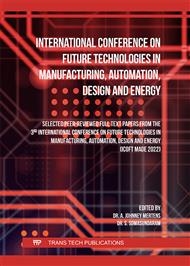p.13
p.19
p.29
p.37
p.45
p.55
p.65
p.75
p.85
Selection of Optimal Machining Parameters by Taguchi-FIS Simulation during Machining of High Tensile Low Alloy Steel
Abstract:
The dry turning was done on the high tensile low alloy steel. The Indoloy carbide tool was used. The input parameters were speed, feed, and depth of cut (DOC, d). The chip reduction coefficient (CRC) and von Mises stress (VMS) were the output responses. Universal tensile testing was done to find out the strength coefficient (K) and strain hardening exponent (n). "K" and "n" were incorporated to obtain the von Mises stress (VMS). The experiments were performed following the L9 array (Taguchi). The analysis of variance (ANOVA) was done for the CRC, with the lower the better condition. The ANOVA was done for VMS with the lower-better condition. The ANOVA was done by developing a MATLAB program. The feed contributed strongly to both the CRC (80.1381% contribution) and VMS (33.1490% contribution) minimizations. A Taguchi-Fuzzy inference system (FIS) simulation was done (MATLAB software) to select optimal parameters. CRC and VMS were the inputs, and MPCI (multi performance characteristic index) was the output for the simulation. The simulation was done based on the rules. The optimal parameters were found at moderate speed, high feed, and moderate DOC. Machining chips were collected for different experimental conditions. The chip form study was done. The chip surfaces were examined in the scanning electron microscope (SEM). The simulation result was validated by chip form study and SEM observation of chip.
Info:
Periodical:
Pages:
45-51
Citation:
Online since:
September 2023
Keywords:
Price:
Сopyright:
© 2023 Trans Tech Publications Ltd. All Rights Reserved
Share:
Citation:


